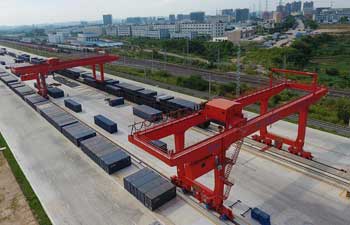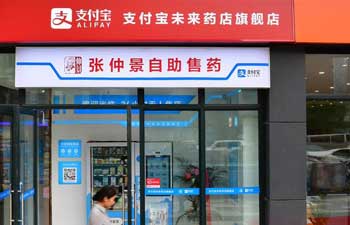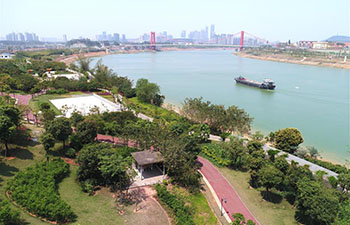NANNING, May 24 (Xinhua) -- Every week, three freight trains run from Chongqing to Guangxi in southern China, carrying cars, car parts, electronics and all kinds of other goods.
From Qinzhou, on the coast of Guangxi, the containers are shipped to Singapore and other ports in Southeast Asia. In the nine months since it opened last September, the route has been an encouraging success. To most destinations, the new route is about two weeks faster than the traditional route through Shanghai.
At the 10th Pan-Beibu Gulf Economic Cooperation Forum in Nanning, capital of Guangxi Zhuang Autonomous Region, Thursday's discussion focused on how the route could be improved.
To take full advantage of the route, Chen Wu, chairman of Guangxi Zhuang Autonomous Regional Government, wants to sweep away all non-tariff trade barriers and build industrial parks. There is also a clear need to build more infrastructure.
Singapore's Tan Wu Meng described the new route as an open platform, available to all parties who wish to make use of it.
"With more stakeholders on board, we will aggregate volume, build economies of scale and lower logistics cost, which will benefit both ASEAN and China," he said.
Trade between China and ASEAN (Association of Southeast Asian Nations) continues to prosper. In Q1, trade between China and ASEAN countries rose 21 percent compared with the same period last year, Gao Yan, vice minister of China's Commerce Ministry, said at the forum. The growth comes after trade volume between the two sides reached a record high last year.
"The immense flow of goods, commerce, capital and information between China and ASEAN is the highlight of the Maritime Silk Road," Gao said.
More importantly, the new sea-rail transit route does not just benefit regions along the route between Chongqing and Singapore. For the first time this month, containers from Vietnam were taken by sea to Qinzhou, then to Chongqing by rail and ultimately on to Germany.
The Singapore - Qinzhou - Chongqing - Xinjiang - Europe link provides China's inland provinces with access to both the Silk Road Economic Belt to the north and the Maritime Silk Road to the south.
Wojciech Zajaczkowski, Polish Ambassador to China, believes that for European countries, the horizon for cooperation should be broader as railway development between Europe and Asia will bring more energy to different regions.
"We believe railway connection between our part of Europe and China can contribute to regional development and that's why we are interested in the Southern Transport Corridor," Zajaczkowski said. "In today's globalized economy, a smooth cooperation in trade, transport and logistics is a precondition for success."

















